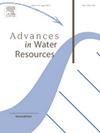Stochastic model for subsurface water flow in Swiss catchments
IF 4
2区 环境科学与生态学
Q1 WATER RESOURCES
引用次数: 0
Abstract
Understanding water movement in catchments subsurface is crucial for numerous applications such as pollutant contamination, nutrient loss, water resource management and ecosystem functioning. Among the variables of particular interest, the transit times of water particles and their statistical distribution are a desirable output. Nevertheless, past approaches assume explicitly the form of the transit time distribution (TTD) to provide information on water age in catchments. In this study we adopt a different approach by making assumptions on the movement of water particles in the subsurface instead of assumptions on the transit time distribution. Hence we propose a model based on a random velocity process with rests, where a water particle alternatively moves with a constant velocity or it is trapped (with zero velocity) until it reaches the outlet of the catchment. We assume that the moving times are i.i.d. (independent and identically distributed) random variables with exponential distribution, while waiting times, i.e., times in which the water particle is trapped in subsurface cavities, are assumed to be i.i.d. random variables with Mittag-Leffler distribution of order , which is heavy tailed. At the catchment outlet, which is assumed here to be at a distance from the inlet equal to the catchment median flow path length , the first passage time (or transit time) of the water particles is measured.
We applied the model to 22 Swiss catchments simulating, for each catchment, the movement of millions of water particles thus obtaining the corresponding empirical TTD. We search for the threshold age () that closely approximates the portion of the empirical TTD younger than , that is the young water fraction (). We use the complex modulus of the empirical characteristic function of the TTD: this quantity represents, in our model, the amplitude ratio of seasonal isotope cycles in stream water and precipitation. Our results reveal that is comprised between 46 and 76 days, exactly in the range 2-3 months previously identified. Additionally, given the amplitude ratio of isotopic concentrations, we estimate the only parameter of the model, that is the parameter of the Mittag-Leffler distribution, for each Swiss catchment using suitable catchments properties. In conclusion, our study reveals that random velocity processes with rests are stochastic transport processes useful for modeling water movement in heterogeneous catchments, with a limited number of assumptions.
瑞士集水区地下水流的随机模型
了解地下集水区的水运动对于污染物污染、养分损失、水资源管理和生态系统功能等许多应用至关重要。在特别感兴趣的变量中,水粒子的传递时间及其统计分布是理想的输出。然而,过去的方法明确地假设了传递时间分布(TTD)的形式来提供集水区水龄的信息。在这项研究中,我们采用了一种不同的方法,即假设水粒子在地下的运动而不是假设传递时间分布。因此,我们提出了一个基于随机速度过程的模型,其中一个水粒子要么以恒定速度移动,要么被捕获(零速度),直到它到达集水区的出口。我们假设运动时间为指数分布的i.i.d(独立同分布)随机变量,而等待时间,即水粒子被困在地下空腔中的时间,则假设为重尾的α阶mitag - leffler分布的i.i.d随机变量。在集水口处,假设其与入口的距离等于集水口流动路径的中间长度L,测量水粒子的第一次通过时间(或传递时间)。我们将该模型应用于瑞士22个集水区,对每个集水区进行数百万水粒子的运动模拟,从而获得相应的经验TTD。我们寻找阈值年龄(τ -百科),它非常接近比τ -百科年轻的经验TTD部分,即年轻水分数(Fyw)。我们使用TTD经验特征函数的复模量:在我们的模型中,这个量代表了河流和降水中季节同位素循环的振幅比。我们的研究结果显示,τ -由46至76天组成,正好在之前确定的2-3个月的范围内。此外,考虑到同位素浓度的振幅比,我们估计了模型的唯一参数,即Mittag-Leffler分布的α参数,用于每个瑞士流域使用合适的流域属性。总之,我们的研究表明,随机速度过程与休息是随机输运过程,有助于模拟非均质集水区的水运动,假设数量有限。
本文章由计算机程序翻译,如有差异,请以英文原文为准。
求助全文
约1分钟内获得全文
求助全文
来源期刊

Advances in Water Resources
环境科学-水资源
CiteScore
9.40
自引率
6.40%
发文量
171
审稿时长
36 days
期刊介绍:
Advances in Water Resources provides a forum for the presentation of fundamental scientific advances in the understanding of water resources systems. The scope of Advances in Water Resources includes any combination of theoretical, computational, and experimental approaches used to advance fundamental understanding of surface or subsurface water resources systems or the interaction of these systems with the atmosphere, geosphere, biosphere, and human societies. Manuscripts involving case studies that do not attempt to reach broader conclusions, research on engineering design, applied hydraulics, or water quality and treatment, as well as applications of existing knowledge that do not advance fundamental understanding of hydrological processes, are not appropriate for Advances in Water Resources.
Examples of appropriate topical areas that will be considered include the following:
• Surface and subsurface hydrology
• Hydrometeorology
• Environmental fluid dynamics
• Ecohydrology and ecohydrodynamics
• Multiphase transport phenomena in porous media
• Fluid flow and species transport and reaction processes
 求助内容:
求助内容: 应助结果提醒方式:
应助结果提醒方式:


